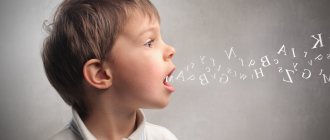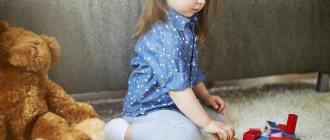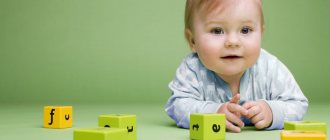When should a child start speaking in sentences?
Normally, the formation of speech in a child goes through several stages: screaming, humming, babbling, and already from 11-12 months of life the baby begins to utter his first words. He begins to associate words with objects in the environment, words are filled with meaning for him. By this time, the child has already formed an active (from 3 to 10 spoken words) and passive (up to 20 understood words) vocabulary. By the age of 1.5 years, the vocabulary increases to 40-70 words, and at 2 years the baby already uses from 150 to 300 words. On average, at the age of 2 years, a child begins to speak in sentences. At first they consist of two words (mama give, lalya boo, etc.), and then of three or four.
Of course, each child develops strictly individually, and there may well be minor delays in the development of speech functions, which are not yet a deviation, but depend solely on the child himself, his temperament or heredity. But if you observe that your child does not speak in sentences for quite a long time, or he has missed previous stages of speech formation, this may indicate a delay in psychospeech development (DSRD).
Delayed psycho-speech development
There are quite a few reasons for the development of ZPRD, among the most common:
- Illness of the mother during pregnancy or difficult childbirth;
- Intrauterine hypoxia of the fetus, trauma to the child during childbirth (trauma of the cervical spine and/or central nervous system);
- Serious illnesses suffered by a child at an early age;
- Psycho-emotional trauma at an early age;
- Unfavorable family environment or improper upbringing (beatings, quarrels, lack of love and care on the part of parents or, conversely, excessive care).
In addition to the fact that your child over 2 years old does not speak in sentences, symptoms that also indicate the presence of delayed speech development are:
- limited vocabulary (up to 3 years of age, a child should normally know 1200-1500 words);
- reluctance to make verbal contact, even with relatives;
- the child speaks too slowly or, conversely, quickly, swallowing the endings of words;
- cannot repeat a phrase after an adult;
By the age of 5, the child’s speech apparatus has finally matured, the lips, palate and tongue adapt to difficult sounds, and the child’s age is revealed only by his sonorous voice. Therefore, if you notice symptoms of PVD in your child, it is extremely important to consult a neurologist as soon as possible. In this case, the sooner you start treatment, the better results you will achieve.
How to properly communicate with a child with hearing loss?
When talking to your child, make sure he can see your lips. Reading lips is very important for him. If you want to draw your child's attention to a toy (or object), bring it to your lips and talk about it, holding it at mouth level. Talk to your child with your lips 10-15 centimeters away from the baby's ear, or increase the strength of your voice.
Don't be afraid to use meaningful gestures. You can come up with a whole system of gestures that only you and your child can understand. These gestures have nothing to do with the “deaf language” that many parents fear. They will help your child learn to understand the meaning of many words and communicate with you until he learns to speak.
Rich facial expressions can be an additional tool that will help your baby understand speech addressed to him. Exaggerated facial expressions of joy, fear, delight, fear will allow the child to better understand what you want to tell him. Teach your child to express his desires and needs using the means of communication available to him - gestures, facial expressions, intonation, words.
Ear pain in a child is not always otitis media. What other reasons could there be?
Ear pain is a fairly common ailment in childhood. One of the diseases that foreshadows ear pain is otitis media. According to statistics, it affects 75% of children under the age of 5 years, and children under 2 years of age are most susceptible to it.
Having heard from a child: “My ear hurts,” a parent is usually very worried, because the child cannot reliably determine the exact location and extent of the pain. Ear pain can also be caused by otitis externa.
DID YOU KNOW THAT... The inner ear is not innervated by sensation, so discomfort associated with it will not cause pain. What could be the causes of ear pain in a child? Here are the most common of them:
1. Pain Associated with Ear Diseases (Primary Otalgia) Primary otalgia is ear pain caused by rolling ear disease. Usually the pain is sharp, strong, increasing, localized in the ear, and with the disappearance of the disease, the pain decreases.
Causes of ear pain associated with ear diseases:
- acute otitis media;
- acute vesicohemorrhagic otitis media;
- exacerbation of chronic inflammatory processes of the ear;
- squeezing of the ear;
- spontaneous rupture of the eardrum;
- mechanical injuries, burns, frostbite;
- wax plugs;
- bacterial inflammation of the external auditory canal;
- complications after chickenpox and herpes zoster;
- inflammation of the cartilaginous auricle;
- hematomas and post-traumatic abscesses of the auricle;
- advanced tumor processes.
Among the above reasons, acute otitis media predominates. This inflammation develops suddenly and is accompanied by the presence of discharged pus - a consequence of viral or bacterial infections of the upper respiratory tract. It may also be due to dysfunction of the eustachian tube.
Otitis media can be acute or chronic. They also talk about exudative (when fluid accumulates) and mucous inflammation (when the fluid has the consistency of mucus). Most often it is accompanied by stinging pain, increased body temperature, sleep disturbances, and discharge from the ear.
2. Secondary otalgia - when ear pain is caused by another disease. Secondary otalgia, that is, ear pain resulting from diseases not directly related to the hearing organs. This type of pain is less concentrated in one place and more intense, and is slower to increase and return.
Causes of ear pain not related to the hearing organ:
- acute inflammation of the tonsils and complications in the form of peritonsillar abscess;
- injuries around the larynx;
- inflammation caused by esophageal-laryngeal reflux;
- diseases of the temporomandibular joint;
- inflammation of the salivary glands;
- inflammation of teeth;
- inflammation of the floor of the mouth;
- neoplastic conditions of the nasopharynx.
Inflammation of the tonsils is the most common cause of ear pain in children, which does not depend on the ear itself.
REMEMBER! When ear pain is associated with a condition affecting another part of the body, other symptoms usually develop earlier or in parallel.
What should you be concerned about? How to react? In the case of young children, it is difficult to objectively determine the level of pain, and sometimes even its exact location. Therefore, the task of parents is to carefully examine the ear for possible purulent discharge or the presence of a foreign body.
If you don't notice other symptoms besides ear pain, give your child a pain reliever in a dose appropriate for his age and weight. In this case, it is necessary to carefully monitor him. If the pain persists or any of the following symptoms appear, contact your GP, who will order detailed tests or refer you to an ENT specialist if necessary.
Alarming symptoms:
- any education;
- abscesses;
- deformations and asymmetries;
- lack of full range of tongue movements, mouth opening, and throat opening;
- voice timbre disturbances;
- hoarseness;
- swollen lymph nodes;
- nausea, vomiting.
Tongue dysfunction: how it affects teeth
The habit of breathing through the mouth, including during sleep, leads to increased tongue dysfunction. The child begins to stick out his tongue more often (and the tongue is the strongest oral muscle), make additional efforts and press his tongue on the teeth.
What will happen to the teeth if such a habit develops?
- A diastema may form - a gap between the front teeth.
- The contacts of the teeth in the frontal region may be disrupted, then an open bite will appear - a pathology that is quite difficult to correct: it causes noticeable harm to the condition of the teeth, since the entire load falls on the chewing teeth in the lateral regions.
Open bite in a child
- The front teeth can rotate (turn around their axis) or form a protrusion - a forward tilt.
Children's teeth are quite pliable, as the child grows, the size of his jaws and the space in the row of teeth constantly increase. Therefore, the effort exerted by the tongue is quite enough to move the teeth, but they will no longer be able to return back to the correct position on their own.
One more problem
In addition to orthodontic disorders, difficulties with pronouncing sounds will increase. Speech therapy correction is designed for the correct structure of the teeth and the functioning of the tongue, so classes with a speech therapist will be very long and ineffective if the main cause of poor diction is not eliminated.
Speech development from 0 to 12 months
A pediatrician and a pediatric neurologist evaluate the baby’s development in accordance with existing standards:
- by 6 months the child begins to babble and coo;
- per year can pronounce a few simple words.
But the child’s development does not always correspond to the “standard”. A number of factors influence when a baby learns to speak:
- the course of pregnancy and childbirth;
- education methods;
- gender
In most cases, girls start talking earlier than boys. And speech defects are diagnosed more often in boys. Genetic determination is also important: if relatives suffered from speech disorders, then the risk of their occurrence in the child increases.
The reason to contact a speech pathologist is a 1.5 year old child’s inability to understand simple words and a complete lack of speech at 1.9 years old.
Many parents are proud that a year and a half year old child speaks in long sentences and has a large vocabulary. But this is too much of a burden for the baby’s unformed nervous system. You should walk more with your child in the fresh air, relax, and minimize the information flow.
What to do if the child does not speak
Many young parents think that developing a child’s speech is very complicated and difficult. But there are also simple actions that a child can do at home every day playfully.
To help develop the articulatory apparatus or strengthen it, you can lick jam from a saucer, lick ice cream or candy, bite an apple or gnaw a carrot, or move a piece of food in your mouth from one cheek to the other. When a child eats, all the organs necessary for good articulation are trained. It is also useful to rinse your mouth and drink through a straw, blow on a candle and send air kisses to each other, blow soap bubbles and blow on the white heads of dandelions.
To develop fine motor skills, you can collect beads, move small objects with two fingers, etc.
To develop a child’s hearing, you can play “Guess the Sound”, that is, make sounds with different objects, and the child must guess what sounds like; you can sing songs together. When the baby is very small, it is important that he sees your face, your mouth when you talk to him.
All these simple games help prepare the articulatory apparatus, develop the child’s speech, and create an emotionally positive environment, which helps the baby develop.
Which doctor should I contact?
If you notice that your child’s speech development lags behind his peers, then do not put off visiting the following specialists: otolaryngologist, neurologist, speech therapist and/or speech pathologist, psychologist. These doctors will draw up an individual plan for the child’s activities and will be able to choose the type of therapy that is most suitable for your child.
The main thing is to do the tasks given by the specialist systematically, and not once a month. It is the system that leads to a good, sustainable result.










